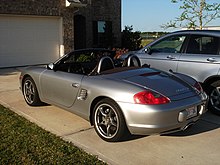Porsche Boxster (986)
| Porsche 986 | |
|---|---|
Porsche 987 |
The Porsche 986 is the internal designation for the first generation
The 986 stimulated a commercial turnaround for Porsche, which during the early 1990s had been suffering with an ageing product range and falling sales, and it's credited with saving the company.[1][2] The 986 Boxster was Porsche's biggest volume seller from its introduction in 1996 until the introduction of the Cayenne sport utility vehicle in 2003.[1]

Development


In October 1991, following a visit to the
By June 1992, out of 4 proposals based on dual collaboration between the 986 and 996 (993's successor) design teams, a proposal by Grant Larson and
In August 1992, a decision was made to develop the concept into a show vehicle, in time for the 1993 North American International Auto Show. After garnering widespread acclaim from the press and public upon presentation of the Boxster Concept in January 1993, the final production 986 production exterior design by Larson was frozen in March 1993. However, by the second half of 1993, difficulties arose with fitment of some components, resulting in lengthening of the hood and requiring another design freeze by fourth quarter of that year. Prototypes in 968 bodies were built to test the mid-engine power train of the 986 by the end of 1993, with proper prototypes surfacing in 1994. Pilot production began in the second half of 1995, ahead of series production in mid-1996.[1]
Through consultation with
Production of the 986 began at the former 928 facility in Stuttgart, Germany in 1996. Valmet Automotive also manufactured Boxsters under contract to Porsche at a facility in Uusikaupunki, Finland. The cars assembled in Finland have the letter "U" as the 11th character of the VIN instead of the "S" in the German assembled cars.[4]
Engine


The 986 Boxster uses the M96, a water-cooled,
Facelift
The model received a minor facelift in 2002. The plastic rear window was replaced by a smaller glass window with a heating element. The interior received a glove compartment, new electro-mechanical hood and trunk release mechanism (with an electronic emergency release in the fuse box panel) and an updated steering wheel. Porsche installed a reworked exhaust pipe and air intake.[5] In addition, the front headlight's amber indicators were replaced with clear indicators. The rear light cluster was also changed with translucent grey turn signals replacing the amber ones. The side marker lights on the front wings were changed as well from amber to clear, except on American market cars where they remained amber. The bumpers were also changed slightly for a more defined, chiseled appearance, and new wheel designs were made available.[6]
Boxster 986 model history
| Year | Engine and power | Transmission | 0–100 km/h (0–62 mph) |
0–60 mph (0–97 km/h) | Top speed |
|---|---|---|---|---|---|
| 1996 | 2.5L, 204 PS (201 hp; 150 kW) | Manual | 6.9 seconds | 6.7 seconds | 240 km/h (149 mph) |
| Tiptronic | 7.6 seconds | 7.4 seconds | 235 km/h (146 mph) | ||
| 2000 | 2.7L, 220 PS (217 hp; 162 kW) | Manual | 6.6 seconds | 6.5 seconds | 250 km/h (155 mph) |
| Tiptronic | 7.4 seconds | 7.2 seconds | 245 km/h (152 mph) | ||
| 3.2L S, 250 PS (247 hp; 184 kW) | Manual | 5.9 seconds | 5.6 seconds | 260 km/h (162 mph) | |
| Tiptronic | 6.5 seconds | 6.2 seconds | 255 km/h (158 mph) | ||
| 2003 | 2.7L, 225 PS (222 hp; 165 kW) | Manual | 6.4 seconds | 253 km/h (157 mph) | |
| Tiptronic S | 7.3 seconds | 248 km/h (154 mph) | |||
| 3.2L S, 258 PS (254 hp; 190 kW) | Manual | 5.7 seconds | 264 km/h (164 mph) | ||
| Tiptronic S | 6.4 seconds | 258 km/h (160 mph) |
Boxster S Special Edition

In 2004, the Boxster S Special Edition, also called 550 Spyder Boxster S Special Edition was introduced with a production run of just 1,953 cars (paying homage to the
References
- ^ a b c d e Bell, Lyndon Conrad (30 March 2016). "A Look Back at the Car that Saved Porsche: 20 Years of the Boxster". Road and Track.
- ^ a b Frankel, Andrew (26 December 2016). "Porsche Boxster: the car that saved the company". Telegraph.
- ^ Lawrence Ulrich (17 August 2012). "Porsche's Baby Turns 16 - Seeks a Bigger Allowance". The New York Times.
- ^ a b McKay, Malcolm (8 February 2019). "Buyer's guide: Porsche Boxster 986". Classic and Sports car magazine. Retrieved 16 June 2020.
- ^ a b Bedard, Patrick (1 January 2000). "Porsche Boxster S: A sports car to get sappy over-no ifs, ands, and very few buts". Car and Driver. Retrieved 16 June 2020.
- ^ Burgess, Peter (September 2002). "MR archive: Porsche Boxster S 986 review". Motoring Research. Retrieved 16 June 2020.
- ^ "Porsche launches "50 Years of the 550 Spyder" branded Boxster S". Classic Driver Magazine. 3 December 2003. Retrieved 16 June 2020.
- ^ Vaughn, Mark (9 May 2004). "2004 Porsche Boxster S Special Edition: 50 years of the Spyder: Porsche celebrates the golden anniversary of the 550". Autoweek. Retrieved 16 June 2020.
